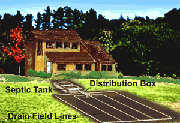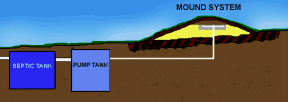RESTORING SEPTIC DRAIN FIELDS
The drain field soil processes wastewater coming from the septic tank before it returns to the water table. All systems rely on the ability of the drain field soil to absorb water. Naturally occurring bacteria in the drain field soil digest pathogens and other organic material collecting there.

Gravity Fed
A typical drain field is gravity fed. It usually consists of several gravel-filled trenches with perforated drainpipe buried just below the surface of the gravel running the length of the trenches. The effluent is distributed, usually through a distribution box, to the various lateral drainpipes exiting through the perforations into the surrounding gravel bed. Secondary processing begins in these beds as the effluent fills the trench then seeps through the bio mat and into the surrounding soil. There are many other configurations commonly in use.

Infiltrator ® systems
A more recent technology, Infiltrator chambers are hollow structures that attach end-to-end. They are installed in trenches or beds without gravel (except where local codes require the use of gravel). The entire bottom of the trench is open for unobstructed infiltration of water. The large storage volume within the hollow chambers accommodates peak flows of effluent from the home. Infiltrator chambers also feature patented sidewall louvers that allow lateral leaching of effluent into the soil.

Mound Systems
On problem sites, mound systems may be an alternative. In a mound system, septic tank effluent is delivered to the mound through the use of a pump in a dosing tank placed after the septic tank. The mound itself is carefully constructed above ground using specially selected sand placed on top of the natural soil to help treat and dispose of septic tank effluent. The depth of sand is determined by the depth of the natural soil above a limiting layer. A limiting layer can be bedrock, a soil layer with a very low percolation rate, or seasonally high groundwater. The depth of sand added to the depth of the natural soil must equal the minimum treatment depth prescribed by local authority.
All these different types of systems have one thing in common: they all rely on the ability of the soil to absorb water.
How to restore drain field soil.
Good results have been obtained by using a shock treatment consisting of four gallons of SEPTIC PERC® applied directly to the drain field, bypassing the septic tank. This dosage is suitable for a home with three bedrooms and two bathrooms. Larger drain fields may require greater amounts. For severely degraded systems use our Combo SHOCK Treatment: 4 gallons of SEPTIC PERC® and 8 ounces of Mega Bio applied directly to drain field soil.

